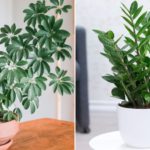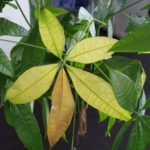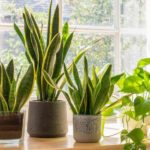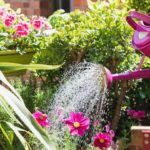Garden enthusiasts who love houseplants are sure to be envious when they see flowers and plants grown by others flourishing with lush green leaves and beautiful flowers, while their own plants have yellowing leaves and rotten roots.
In reality, the most important thing for growing houseplants at home is to maintain healthy roots. Therefore, you need to ensure that the soil has good air circulation and drainage.
 The most important thing for growing houseplants at home is to maintain healthy roots.
The most important thing for growing houseplants at home is to maintain healthy roots.
If you fail to do this, even with minimal watering, the roots can easily become rotten, which is not beneficial for growth and development.
Therefore, to prevent yellowing leaves and rotten roots, you should place these small waste materials in the pot before covering them with soil and planting the plants.
At the same time, you should take corresponding measures to improve the permeability of the soil, so that the roots can breathe smoothly. This way, the roots will grow longer and stronger, without the risk of rotting. The pot of houseplants will become more and more prosperous over time.
 Placing these pieces of ceramics at the bottom of the pot can help the soil drain better.
Placing these pieces of ceramics at the bottom of the pot can help the soil drain better.
1. Place “ceramic shards” under the pot of houseplants
Usually, you might have some broken ceramic bowls or plates at home. Instead of throwing them away, you can use them for planting houseplants. These ceramic bowls and plates are fired at high temperatures and do not contain bacteria or germs.
They can be used for planting houseplants. Placing these pieces of ceramics at the bottom of the pot can help the soil drain better.
In doing so, if you accidentally pour too much water, it will quickly flow down the gaps and evaporate quickly.
Do not underestimate these broken pieces. When you accidentally pour too much water, they will help drain the water quickly. At the same time, when the roots grow downwards, a well-drained bottom of the pot will allow the roots to grow stronger.
 Add charcoal to the soil or as a cushion at the bottom of the pot to improve air circulation and drainage.
Add charcoal to the soil or as a cushion at the bottom of the pot to improve air circulation and drainage.
2. Charcoal can provide good water drainage and nutrition for houseplants
Charcoal might not be readily available in cities, but it is quite common in rural areas. Many people still use charcoal for cooking, especially street food vendors who save money.
Charcoal, after being burned, becomes charcoal residues. Charcoal residues have many empty spaces inside, making them light and porous.
Adding charcoal to the soil or using it as a cushion at the bottom of the pot of houseplants can improve air circulation and water drainage.
 Charcoal residues can also release various trace elements, supplement nutrients, and promote growth.
Charcoal residues can also release various trace elements, supplement nutrients, and promote growth.
Excess water will be drained out through the gaps. It can also be absorbed by the pores to serve as a water reservoir. Charcoal residues act like a small reservoir, slowly releasing water without worrying about overwatering.
Charcoal residues can also release various trace elements, supplement nutrients, and promote growth.
Having charcoal residues in the pot of houseplants can promote comprehensive root development. Large pieces of charcoal can be placed at the bottom of the pot, while smaller pieces can be mixed into the soil for planting houseplants, which is very useful.
 The shape and structure of pine cones are relatively special, making them light and well-aerated.
The shape and structure of pine cones are relatively special, making them light and well-aerated.
3. Throw pine cones into the pot of houseplants to improve aeration
April is the best season for outings. Many people choose this time to visit parks, go hiking, exercise, and breathe fresh air.
If you go up the mountain and come across a lot of pine cones, remember to pick them up. Pine cones have a relatively special shape and structure, making them light and well-aerated.
 Pine cones provide good nutrients for houseplants.
Pine cones provide good nutrients for houseplants.
You can break the pine cones into small pieces and place them at the bottom of the pot of houseplants to improve aeration. You can also add them to the soil to adjust its pH and increase the organic matter content. These have a positive effect on promoting the development of acid-loving houseplant roots.
However, for safety reasons, the pine cones you bring home should be washed with clean water to avoid any remaining insects or disease. Soak them in a purple solution, then let them dry in the sun for a few days before use.
 Layering this material at the bottom of the pot of houseplants can trap sediments and prevent them from being washed away when watering.
Layering this material at the bottom of the pot of houseplants can trap sediments and prevent them from being washed away when watering.
4. Loofah fibers help houseplants drain well and prevent soil washout
If you grow flowers in the countryside, you might find dried loofah fibers. Take the inner spongy part of the loofah and use it to line the bottom of the pot. Peel the loofah, flatten it, and spread it directly at the bottom of the pot, covering the drainage holes. Fill the pot with nutrient-rich soil for planting flowers and houseplants.
Layering this material at the bottom of the pot of houseplants can trap sediments and prevent them from being washed away when watering.
At the same time, it can make the soil in the pot more permeable, benefiting the development of the plant and its root system.
 Styrofoam helps reduce the weight of the pot and improve air circulation.
Styrofoam helps reduce the weight of the pot and improve air circulation.
5. Styrofoam helps reduce the weight of the pot and improve air circulation
When repotting plants, if you fill the pot completely with soil, it will not only make the soil compact and less permeable to air, but also make the pot of houseplants too heavy, which is not conducive to their growth.
Especially for deep and heavy pots, tall pots of houseplants that cannot be filled with soil. You should fill the pot with a layer of water-permeable and air-permeable material below, which can reduce the overall weight of the pot and facilitate the movement of the pots.
 Especially for deep and heavy pots, tall pots of houseplants that cannot be filled with soil.
Especially for deep and heavy pots, tall pots of houseplants that cannot be filled with soil.
If the flowerpot is too deep, you can temporarily fill it with some waste styrofoam. Break the styrofoam into small pieces, fill it at the bottom, and then pour nutrient-rich soil for planting houseplants. This way, the overall weight of the pot can be reduced, making it more convenient for moving.
These valueless pieces of styrofoam are actually beneficial for the growth of houseplants and reducing the occurrence of rotting roots.
 Use broken tiles to line the bottom of the pot to improve water absorption and drainage.
Use broken tiles to line the bottom of the pot to improve water absorption and drainage.
6. Broken tiles have high water absorption ability, helping houseplants drain well
When repotting houseplants, if you temporarily cannot find suitable materials for lining the bottom of the pot, you can collect some broken tiles. Break the tiles into small pieces and place them directly at the bottom of the pot.
Red tiles are all fired from clay, making them light and well-drained. They can improve the soil’s lightness and aeration when placed at the bottom of the pot of houseplants. This way, even if you accidentally water too much, there will be no water retention that can suffocate the houseplant roots.
 These tiles help improve drainage and prevent sediment from being washed away when watering.
These tiles help improve drainage and prevent sediment from being washed away when watering.
In addition to these 6 small waste items, there are also other magical tools for planting houseplants, such as earthworm castings, pine needles, small stones, corn cobs, etc. After simple processing, these materials can be used to line the bottom of the pot of houseplants. These waste items are beneficial for root respiration, preventing root rot.
Spring is the best season for planting houseplants and repotting them. Many people choose their favorite houseplants during this time and choose the most beautiful pots for them.
During the process of repotting houseplants, many flower lovers often overlook a small detail: lining the pot with a layer of drainage material.
This may be a small detail, but it has a significant effect. A layer of drainage material can not only prevent dirt from flowing out of the pot but also increase the soil’s permeability in the pot, allowing the plant’s root system to grow thick and avoid waterlogging conditions.
According to Dân Việt




































